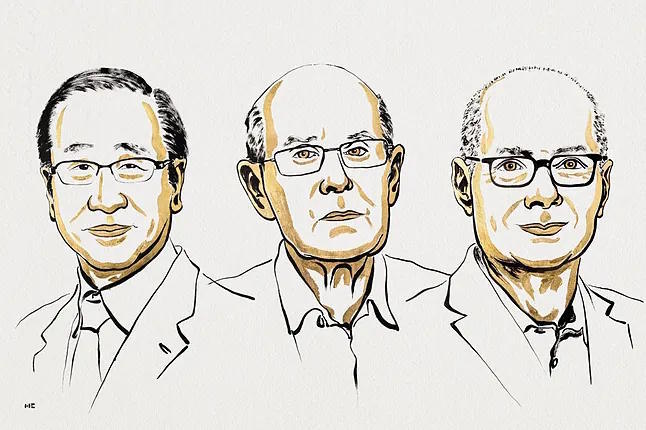The Nobel Prize in Chemistry 2025 has been awarded to the Japanese Susumu Kitagawa, the Englishman Richard Robson, and the Jordanian Omar Yaghi for creating metal-organic structures that can be used to extract water from desert air, capture carbon dioxide, store toxic gases, or catalyze chemical reactions.
"Metal-organic frameworks (MOFs), have enormous potential and provide unprecedented opportunities for tailor-made materials with new functions," says Heiner Linke, chairman of the Nobel Chemistry Committee.
It all began in 1989 when Richard Robson, a Ph.D. from the University of Oxford and a professor at the University of Melbourne, Australia, experimented with the properties of atoms. He combined positively charged copper ions with a four-armed molecule that had a chemical group attracted to the copper ions at the end of each arm. When combined, they joined to form a broad and orderly crystal, like a diamond full of countless cavities.
Robson immediately recognized the potential of his molecular construction, but it was unstable and easily collapsed. However, Dr. Susumu Kitagawa from the University of Kyoto and Professor Omar Yaghi from the University of Berkeley laid the solid foundations for this new construction method. Between 1992 and 2003, they separately made a series of revolutionary discoveries. Kitagawa demonstrated that gases could flow in and out of the constructions and predicted that MOFs could become flexible. Yaghi, who was also awarded the BBVA Foundation Frontiers of Knowledge Award in Basic Sciences in 2017, created a very stable MOF and demonstrated that it can be modified through rational design, giving it new properties.
"The simple explanation: they are very porous materials, like sponges, with many channels and a lot of internal surface area where many reactions can take place. They can be used for catalysis, absorb gases like CO2, and capture it for reuse or removal from the atmosphere," says Fernando Gomollón Bel, Ph.D. in Organic Chemistry, in statements to the Science Media Centre (SMC).
Following the groundbreaking discoveries of the awardees, chemists have built tens of thousands of different MOFs. A real estate agent could describe one of these metal-organic frameworks as "an attractive and very spacious studio, specially designed for your life as a water molecule." Some of them could help solve some of humanity's greatest challenges, with applications including capturing carbon dioxide, collecting water from desert air, separating chemicals from water, releasing drugs inside the body, or managing extremely toxic gases. Some can trap ethylene gas from fruits —to slow down ripening— or encapsulate enzymes that break down antibiotic residues in the environment.
"Designing new materials is one of the most important things we can do to solve our problems, for example, the development of clean energy sources," Yagui stated when awarded the Frontiers Prize.
"They are literally like molecular sponges, microscopic sponges, made of metals and organic substances, which is why they are called Metal Organic Frameworks (MOFs)," explains Bel. "They have metal nodes and organic substances. The beauty of this is that both parts, metals and organic substances, can be customized to some extent. If you change the metal or the organic substances, the properties change. For example, if you use a basic substance as the organic substance, you can create MOFs that react with CO2 —which is acidic— and trap it."
"The work of Yaghi, Kitagawa, and Robson has opened the doors to a new universe of materials. They have shown that by combining metals and small molecules like Lego pieces, it is possible to design structures with practically unlimited geometries, each optimized to fulfill a very specific function," says Jorge Albalad Alcalá, member of the Supramolecular NanoChemistry and Materials group at the Catalan Institute of Nanoscience and Nanotechnology (ICN2), in statements to the SMC. "With a dose of geometry, chemistry, and a bit of 'magic,' today we can imagine, design, and build the perfect material for each challenge: from capturing CO from the atmosphere, storing energy cleanly, or even extracting water from the air in the middle of the desert. What began as a silent revolution in materials chemistry has ended up forever transforming the way scientists understand and create matter."
"The beauty of these materials is that in a very small space, you have a lot of surface area for whatever you need: reactions, catalysis, gas absorption... and this is being applied industrially," concludes Bel.
